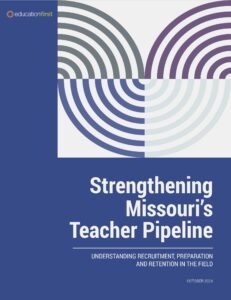 Research shows that an effective teacher is one of the most significant school-based levers influencing student achievement and students’ life outcomes. Missouri students need teachers who are prepared with the content knowledge and instructional skills to make a positive impact on their learning from day one.
Research shows that an effective teacher is one of the most significant school-based levers influencing student achievement and students’ life outcomes. Missouri students need teachers who are prepared with the content knowledge and instructional skills to make a positive impact on their learning from day one.
Schools across Missouri currently face difficulties in finding enough appropriately certified teachers and in maintaining a stable teacher workforce. Over the past decade, the educator ecosystem in Missouri has faced growing challenges, particularly in the number of vacancies and inappropriately filled teaching roles.
Over the past two years, the State Board of Education’s Teacher Recruitment and Retention Blue Ribbon Commission took a close look at teacher pay, climate and culture and provided a series of legislative and policy changes intended to support teacher recruitment and retention. Since then, the state has implemented several of the recommendations, including increasing the starting beginning teacher salary to $40,000, appropriating money for a teacher baseline salary grant and reinstating funding for the Career Ladder Program. The Missouri Department of Elementary and Secondary Education’s Office of Educator Quality has also led exciting new initiatives such as the introduction of state-funded Grow-Your-Own program grants, the TeachNow professional development program for new teachers and the continued support of the Beginning Teacher Assistance Program (BTAP). While these recent changes are promising, they alone are not enough to address the challenges facing Missouri. It is crucial that Missouri students are prepared to face the economy of the future—and that begins with effective, high-quality teachers. Ensuring those teachers reach, stay and thrive in the classroom.
The highest percentage of vacancies filled appropriately are in rural districts, while the highest overall number of vacancies filled inappropriately are in cities and suburbs
Teacher vacancies particularly affect students of color and students from low-income backgrounds.
In the 2023-24 school year, almost a third of first-year teachers had substitute certifications or no certification.
Our report highlights six key recommendations to help strengthen Missouri’s teacher pipeline:
